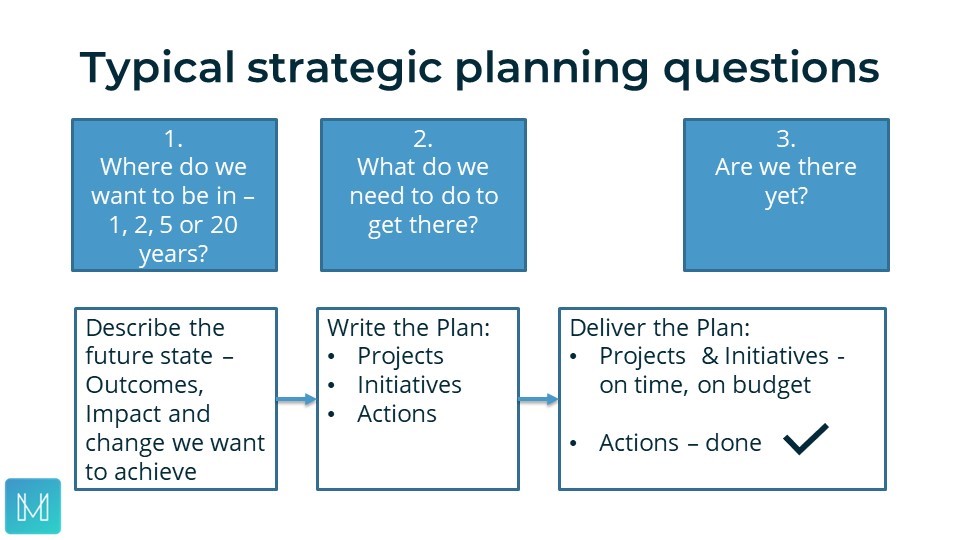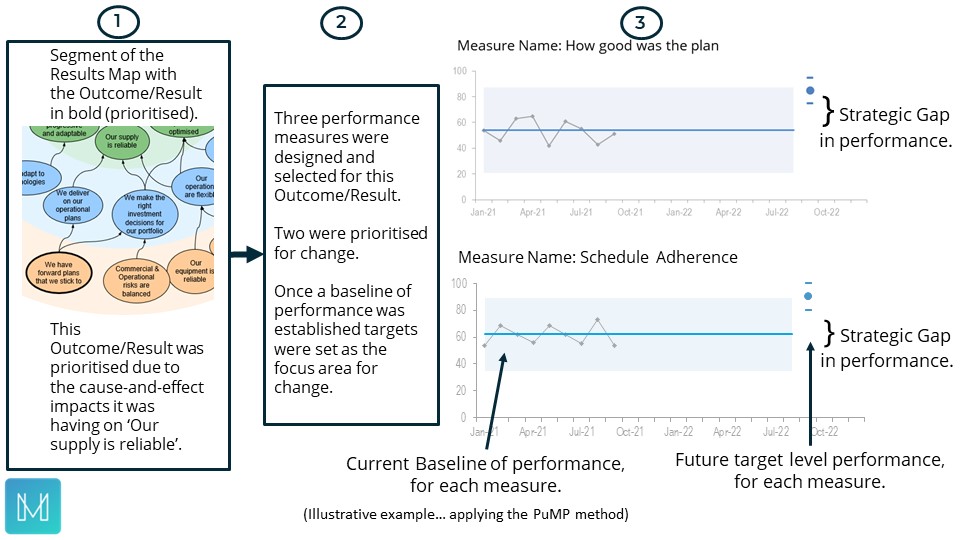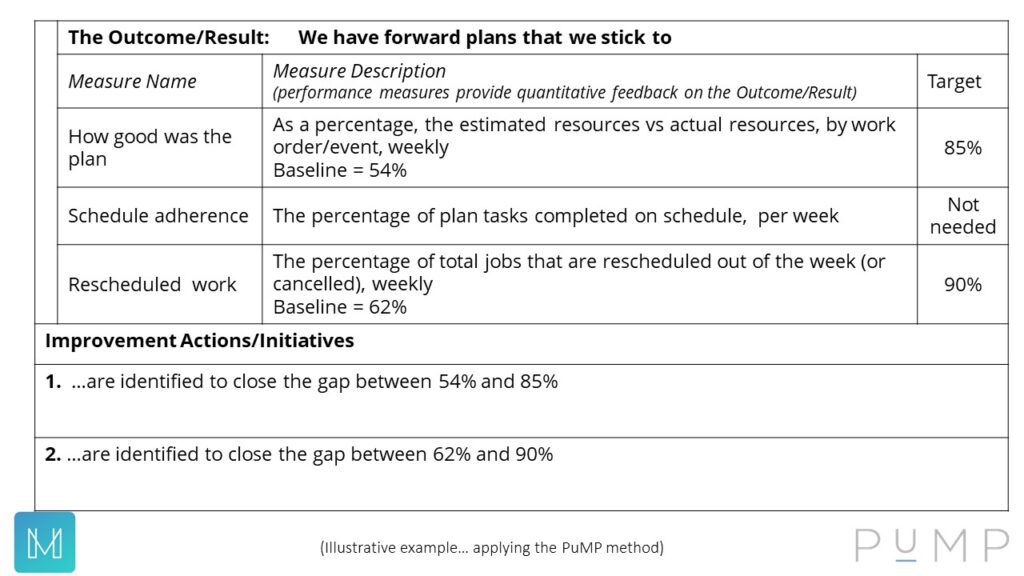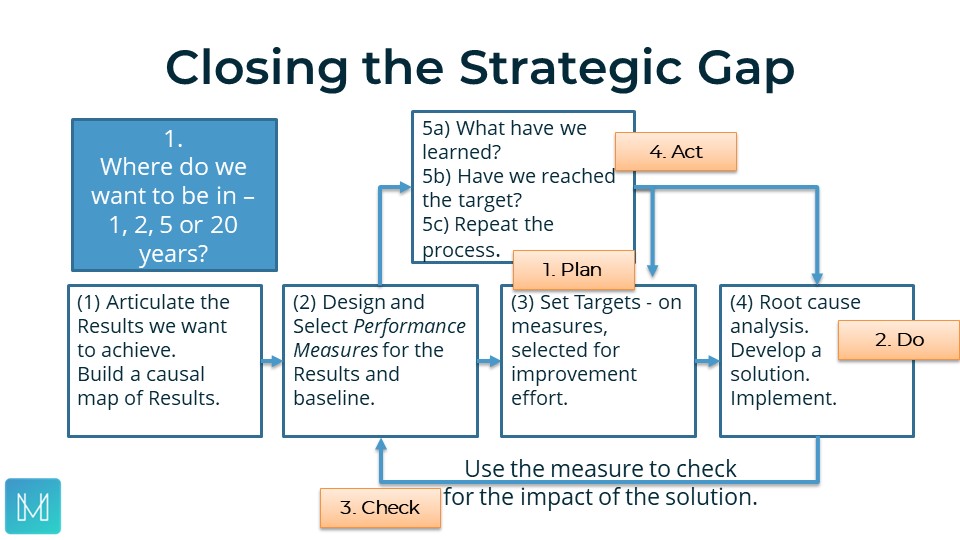Strategy is often developed backwards.
I say backwards because, delivering the actions become the aim. Not making progress towards an overarching aim.
The Strategic Gap is the difference between:
- Where we are today, on prioritised outcomes and the baseline of the related performance measures;
- And where we want to be in the future. Described as a set of targets attached to those prioritised performance measures.
The action plan is designed to close the strategic gap.
If the actions are not closing the gap (as evidenced in the performance measures), then we should re-plan.
We tweak the plan based on our new insights and learnings.
A poorly articulated ‘strategy’ is often the problem when we are trying to close the strategic gap. The overall aim is too vague.
Let’s explore this idea of strategic planning. I will then present a practical solution on how to close the strategic gap in your business or organisation.
Strategic Plans – Background
It is in the business textbook that the organisation needs to have a “strategy”. A Google search tells us that the strategy is: ”a plan of action designed to achieve a long-term or overall aim”.
Google, will also tell us “Strategy” can also be applied to ‘military operations in a war or battle’, which, I feel is a different context for this word.
According to C. Northcote Parkinson (famous for Parkinson’s Law) in, The Rise of Big Business (1977 Weidenfeld and Nicolson, page 229), the first Strategic Plan was developed by Alfred P. Sloan in 1920s. He was the leader of the recently formed General Motors.
Sloan needed the plan to guide the merger of multiple brands of motor vehicles (Buick, Oldsmobile, Pontiac, Cadillac, Chevrolet and Dodge among others).
His ‘strategic plan’, was (in summary) this: each brand would compete, not with each other, but at different price and quality points in the market. The overall aim was to reduce the growth of Ford.
The success of General Motors over the following decades meant that most business schools and textbooks now prescribe a Strategic Plan.
Which all sounds good. We should have an overall aim and an action plan.
Strategic Plans – Today
Over the years I have been accredited in, and used many different approaches to “strategy development” and “planning processes”.
Whilst these processes produce a Strategic Plan, in the application or implementation of that planning something always seems to go awry.
Broadly speaking, they all seem to have these key steps:
1. Asking the question, where do you want to be in the future (1, 2, 5, or 20 years)…?
2. Once we have an idea of where we want to be in the future, we then ask, how will you get there?
This question produces a list of the projects and initiatives we think we need to implement. These initiatives somehow get prioritised, often through voting, or using the highest-paid-person’s-opinion etc.
Either way we end up with The Plan. A list of projects and things to do, allocated to leader-managers.
3. Then we ask, how will you track progress towards strategy?
With that prioritised list of projects or initiatives, we then monitor the progress of the plan. Did we do what we said we would? And, was it on time and on budget?

Unfortunately, delivering the actions become the aim. Not making progress towards an overarching (strategic) aim.
Strategy Backwards
These days I refer to this process as “strategy backwards”.
What happens is that the “strategy” becomes delivering the list of projects/initiatives.
The ‘overall aim’ of the strategy is regularly a bit vague. The flow on effect is often that leader-managers with the best rhetoric get their projects on the list. Connecting to the overall aim of the strategy is often verbal and opinion based. Not evidence based.
Additionally, these projects/initiatives, that you came up with during a brainstorming (er sorry, planning) session may or may not be the things you need to do.
What happens if a course correction on an action is required? Well, we are committed to delivering the project, no matter what, our reputation and bonus depend on it…
What happens if the projects are delivered but there is no demonstrable contribution towards the overall aim? We start the strategy-backwards process again…
It is strategy backwards because, delivering the actions become the aim. Not making progress towards the overall aim.
So, what then is strategy?
(in my view)
I now define strategy as the difference between where we are today, and where we want to be in the future.
That means:
1. We know the outcomes we want to head towards.
2. We have performance measures telling us what our performance is now.
3. Additionally, we have prioritised the baseline of those performance measures for change.
Here is an illustrative example.

If we use this structure: Outcomes, performance measures with baselines prioritised for change (with targets); our overall aim becomes crystal clear to all. It is the difference between two measurable points in time.
The strategic gap now has an evidence base. As does any action designed to have an impact on the strategic gap.
(You can read more about Results Map in this bog post; or more about the PuMP Method here.)
The Strategic Gap
To keep it real, let’s say this ‘strategic gap’ (between where we are to where we want to be) is one-maybe-two-years maximum. For smaller businesses it could be six, nine, or perhaps 12-to-18 months.
Shorter cycles of performance improvement on specific selected elements seems to work best. Incremental steps towards the overall aim, rather than solutions that tend to be a big bang (generally).
Once we understand the strategic gap, we can then select the actions or projects required to close the gap.
The efficacy of the selected actions will be evidenced by the signals in the performance measures. Which in turn allows for learning. And, if the actions are not closing the gap, we are free to use our learnings and select more impactful actions.
Below is an illustration of having a clear gap between the the current level of performance (the baseline of the performance measures) and future target level of performance. Then using that focus to develop improvement actions or initiatives.

The goal is to learn how to close the strategic gap. Not deliver actions that may or not close the gap.
Setting “strategy” this way can still allow you to be somewhat audacious and set big goals, if you wish.
The point here is that “the overall aim of the strategy” is now a clearly defined change from how things are now, to how we want them to be in the future. The plan is then experimental and learning on how to get that change we have set as the overall aim.
This is how it works in practice.
1. Have a Results Map (Step 2 technique within the PuMP Method for performance measurement). Does not need to be perfected. 90% is good enough.
2. Identify two or three Results/Outcomes that are priorities for change in the next period (one-three years, or 12-18 months).
3. Then design and select performance measures for those results and baseline your current level of performance.
4. Then set targets for change on those performance measures for the prioritised results.
5. Then work out an initial action plan to move towards the targets you have set.
6. Monitor, assess progress (if no change in performance, change the actions to those that will make progress towards the target for the result).
7. Try and work to 90-day cycles of monitoring progress towards the targets, attached to the measures, for the prioritised results.

Your Strategic Plan then becomes:
- A prioritised set of Results/Outcomes (two or three and mapped onto a Results Map),
- With a small number of performance measures (baselined) with targets for improvement attached.
- Actions, improvement efforts are documented in the plan, reviewed every 90 days. Checking for new insights, learnings and ensuring the efforts are still on target for the improvement.
- If the actions selected are not making any change in the performance (evidenced in the measures), or new learnings and understanding indicates a different approach then ‘pivot’ to that.
- Continue with regular monitoring and reviewing to ensure progress towards the targets (attached to the measures) and the prioritised results.
- Success is not hitting the target. We can often be too ambitious with our target setting. Making progress towards the target and gaining new insights and learning is success. The target is only a focus area, progress towards is the goal, not hitting the target…
Closing the Strategic Gap
Is a matter of ensuring we have a very clear overall aim.
This clarity is absolute when we use an Outcome/Result with two-or-three performance measures attached.
We then baseline our current level of performance, and set targets for where we would like to be in the future.
That gap between the current level of performance and the intended future state is the strategic gap to close. Improvement efforts here will be very focused.
Planning and implementation will focus the minds of your teams on how to close the strategic gap.
Featured image photo by Suad Kamardeen on Unsplash



